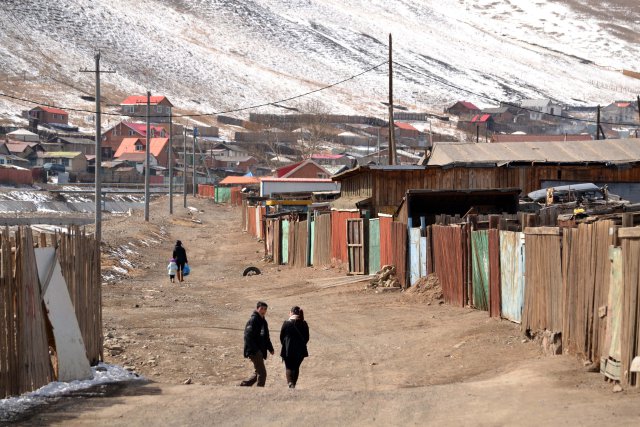The flourishing capital of Mongolia is brimming with opportunities as it faces the challenge to improve the living conditions of slum dwellers affected by the severe Mongolian winter. Our student Noel Sampson reports from Ulaanbaatar where he is interning with UN-HABITAT Mongolia.

“There are so many new rich people and there is no place for them to spend their money” said Rob, a French-US American investor I met on the flight from Moscow to Ulaanbaatar. He told me about the new club and Irish pub he was building – “the biggest in Ulaanbatar,” he promised. I gave a dry smile. The thought of an Irish pub is hard to get excited about. Frankly, they all look the same to me.
Hours later I discovered that the city is already full of Irish pubs, crammed in amongst the office towers under a skyline cluttered with cranes. Up in the surrounding hills, beyond the cranes and city lights, the slums are populated by gers, traditional Mongolian tents, that exhale thick plumes of coal smoke. The khashaas, or individual fenced plots, highlight the organic pattern of the informal urban fabric.
More than 50% of Ulaanbaatar’s population lives in ger-areas and approximately 47% of ger residents live in poverty. Ger-areas have limited infrastructure and services such as heating, water and sanitation. Residents use coal-fired stoves to survive extremely harsh winters with temperatures below -40°C. Domestic coal fires are the main cause for air pollution in Ulaanbaatar where individual households cannot afford to connect to the city’s power grid. Improving access to services would help to upgrade these areas and improve quality of life.

Ger-areas in the district of Selbe
A major cause of the growth of slums in Ulaanbaatar is immigration to the city related to dzud – a concurrent natural disaster characterized by summer drought followed by a particularly harsh winter with extremely low temperatures and heavy snow. The 2010 dzud affected an estimated 769,106 people (28% of the total population) and has resulted in the loss of 8.4 million livestock. Many were forced to resettle in the capital. Other causative factors for the increase of slums include high poverty levels in rural areas, the inexperience of local institutions in dealing with urban issues, natural population growth and the Free Mobility Law approved by the Supreme Court in 2003, which grants every Mongolian the right to freely own a plot of land in the capital.
The challenge in Ulaanbaatar is therefore a matter of land management, affordability of services and adequate housing. Extreme temperatures and slum expansion make services difficult and expensive to implement. To address these issues, the most viable strategy is to densify ger-areas. Residents cannot afford individual connections to services and grouping residents together could potentially reduce the cost for such services.

There is a prominent lack of access to infrastructure and services in Ger-areas
The question lies in how to implement such efforts, in particular, how slum dwellers will participate in the development strategies of the city. Another key task involves creating a financial flux that integrates the private sector, residents and government. Existing efforts towards slum upgrading in ger-areas show that incremental improvements can create a flow-on effect on service provision to surrounding slums that in turn, continue to grow. The opportunities for residents, private businesses, and the city’s development lie in the provision of adequate housing and the improvement of ger-areas.

A booming construction industry is constrained to building only five months of the year due to harsh winters
Perhaps the creation of an entity that acts as fair broker between these three groups could contribute the creation of more affordable housing schemes. Under the support of a newly created public-private entity, residents could create community builders associations or similar co-op housing schemes to enable affordable housing construction. Residents could start a guided and progressive land pooling process that makes land available for public facilities and where living conditions are optimum. This process would allow the community to lease part of the land to the private sector and utilize the resulting income to finance the construction of housing and improved urban spaces.
Moreover, the creation of such an entity could address future concerns such as how to devise compensation systems, how to prevent land speculation and price hikes after the implementation of services, and most importantly, how to guarantee that residents who take part in eventual slum upgrading strategies will obtain fair benefits for pooling or trading their land. Additionally, this entity can stimulate private sector investments in areas that have higher profitable potential, such as land situated along primary roads.

Formation of slums in the peri-urban areas of Ulaanbaatar
A booming national economy thanks to rich mining resources is turning Ulaanbaatar into a land filled with opportunities. But who will seize them and decide its urban future? The private sector is eager to push its own agenda of urban development, while the Mayor, Bat-Uul, has outlined a vision of urban corridors for its slums based on the model of Los Angeles’ Wilshire Boulevard. A sustainable urban model can only exist with the participation of the local community. Empowered residents stand to gain through improved housing that would contribute to the city’s economy and save lives during the harsh Mongolian winters. Perhaps Rob, my co-passenger from the flight in, would also stand to benefit by making a wiser choice and investing in the community.


